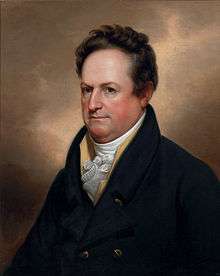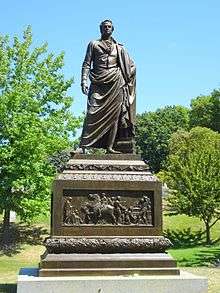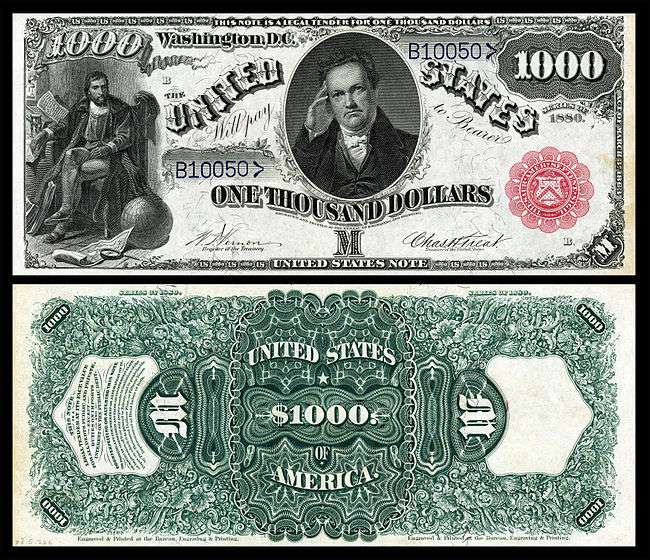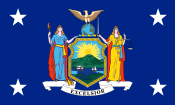DeWitt Clinton
| DeWitt Clinton | |
|---|---|
 | |
| 6th Governor of New York | |
|
In office January 1, 1825 – February 11, 1828 | |
| Lieutenant |
James Tallmadge Jr. Nathaniel Pitcher |
| Preceded by | Joseph C. Yates |
| Succeeded by | Nathaniel Pitcher |
|
In office July 1, 1817 – December 31, 1822 | |
| Lieutenant | John Tayler |
| Preceded by | John Tayler (acting) |
| Succeeded by | Joseph C. Yates |
| Lieutenant Governor of New York | |
|
In office 1811–1813 | |
| Governor | Daniel D. Tompkins |
| Preceded by | John Tayler (acting) |
| Succeeded by | John Tayler |
| Mayor of New York City | |
|
In office 1811–1815 | |
| Preceded by | Jacob Radcliff |
| Succeeded by | John Ferguson |
|
In office 1808–1810 | |
| Preceded by | Marinus Willett |
| Succeeded by | Jacob Radcliff |
|
In office 1803–1807 | |
| Preceded by | Edward Livingston |
| Succeeded by | Marinus Willett |
| United States Senator from New York | |
|
In office February 9, 1802 – November 4, 1803 | |
| Preceded by | John Armstrong Jr. |
| Succeeded by | John Armstrong Jr. |
| Personal details | |
| Born |
March 2, 1769 Little Britain, New York, British America |
| Died |
February 11, 1828 (aged 58) Albany, New York, U.S. |
| Political party | Democratic-Republican |
| Spouse(s) |
Maria Franklin (m. 1796; d. 1818) Catharine Jones (m. 1819) |
| Education |
Princeton University Columbia University (BA) |
| Signature |
|
DeWitt Clinton (March 2, 1769 – February 11, 1828) was an American politician and naturalist who served as a United States Senator, Mayor of New York City and sixth Governor of New York. In this last capacity, he was largely responsible for the construction of the Erie Canal.[1] Clinton was a major candidate for the American presidency in the election of 1812, challenging incumbent James Madison.
A nephew of long-time New York Governor George Clinton, DeWitt Clinton served as his uncle's secretary before launching his own political career. As a Democratic-Republican, Clinton won election to the New York State Legislature in 1798 before briefly serving as a U.S. Senator. Returning to New York, Clinton served three terms as Mayor of New York City and also won election as the Lieutenant Governor of New York. In the 1812 election, Clinton won support from the Federalists as well as a group of Democratic-Republicans dissatisfied with Madison. Though Madison won re-election, Clinton carried most of the Northeastern United States and fared significantly better than the previous two Federalist-supported candidates. After the presidential election, Clinton continued to affiliate with the Democratic-Republican Party.
Clinton served as Governor of New York from 1817 to 1822 and from 1825 to 1828, presiding over the construction of the Erie Canal. Clinton believed that infrastructure improvements could transform American life, drive economic growth, and encourage political participation. He heavily influenced the development of New York State and the United States.[2]
Early life
DeWitt Clinton was born on March 2, 1769, the second son born to Major-General James Clinton and his wife Mary DeWitt (1737–1795).[3] He attended Kingston Academy and began his college studies at the College of New Jersey before transferring to King's College.[4] Kings was renamed Columbia College, and Clinton was the first to graduate under the school's new name.[5] He was the brother of U.S. Representative George Clinton Jr., the half-brother of U.S. Representative James G. Clinton, and the cousin of Simeon De Witt. He became the secretary to his uncle George Clinton, who was then governor of New York.[4] Soon after, he became a member of the Democratic-Republican Party.[4]
Career
New York Legislature and U.S. Senate
He was a member of the New York State Assembly in 1798, and of the New York State Senate from the Southern District in 1798–1802 and 1806–1811[4] He was a delegate to the New York State Constitutional Convention in 1801. He was a member of the Council of Appointments in 1801–1802 and 1806–1807.[4] He won election by the New York State Legislature to the U.S. Senate seat left vacant by the resignation of John Armstrong, Jr., and served from February 9, 1802 to November 4, 1803.[4] He resigned over unhappiness with living conditions in newly built Washington, D.C., and was appointed Mayor of New York City.[4]
Mayor of New York City
He served as Mayor of New York from 1803 to 1807, 1808 to 1810, and 1811 to 1815. While serving as mayor, he organized the New-York Historical Society in 1804 and was its president. He also helped re-organize the American Academy of the Fine Arts in 1808, and served as its president between 1813 and 1817. He was a Regent of the University of the State of New York from 1808 to 1825. Clinton was also elected a member of the American Antiquarian Society in 1814,[6] and served as its vice president from 1821 to 1828.[7] In 1816 he was elected a Fellow of the American Academy of Arts and Sciences.[8]
Lieutenant Governor of New York
In 1811, the death of John Broome left a vacancy in the office of Lieutenant Governor of New York. In a special election, Clinton defeated the Federalist Nicholas Fish and the Tammany Hall candidate Marinus Willett, to become Lieutenant Governor until the end of the term in June 1813.[4]
Presidential campaign
Clinton's uncle, George Clinton, had attempted to challenge James Madison for the presidency in 1808, but was chosen as the party's vice presidential nominee instead. In 1812, after George Clinton's death, the elder Clinton's supporters gravitated towards DeWitt Clinton. Clinton ran for President of the United States as candidate for both the Federalist Party and a small group of anti-war Democratic-Republicans. In the close election of 1812, Clinton was defeated by President Madison; Clinton received 89 electoral votes to James Madison's 128. It was the strongest showing of any Federalist candidate for the Presidency since 1800, and the change of the votes of one or two states would have given Clinton the victory.[9]
Governor of New York

After the resignation of Governor Tompkins, who had been elected Vice President, he won a special gubernatorial election in which he was the only candidate. 1,479 votes were cast for Peter Buell Porter – against Clinton's 43,310 – because the Tammany organization, which fiercely hated Clinton, had printed ballots with Porter's name on them and distributed them among the Tammany followers in New York City. On July 1, 1817, Clinton took office as Governor of New York. He was re-elected in 1820, defeating the sitting Vice President Tompkins in a narrow race – DeWitt Clinton 47,447 votes, Tompkins 45,900 – and served until December 31, 1822.[4]
During his second term, the New York State Constitutional Convention of 1821 shortened the gubernatorial term to two years, and moved the beginning of the term from July 1 to January 1, actually cutting off the last 6 months of the 3-year-term he had been elected to. The gubernatorial election was also moved from April to November, but Clinton was not renominated by his party to run for re-election in November 1822. Even so, he still kept his post as President of the Erie Canal Commission. In April 1824, a majority of his political enemies, the Bucktails, voted in the New York State Legislature for his removal from the Canal Commission. This caused such a wave of indignation among the electorate, that he was nominated for Governor by the "People's Party", and was re-elected governor against the official candidate of the Democratic-Republican Party, fellow canal commissioner Samuel Young. He served another two terms until his sudden death in office.[4]
Clinton was a Freemason, and in 1806, he was elected Grand Master of the Grand Lodge of New York. He retained this title until 1819. The Grand Lodge of New York has established the DeWitt Clinton Award. The Award recognizes distinguished or outstanding community service by non-Masonic organizations or individuals whose actions exemplify a shared concern for the well-being of Mankind and a belief in the worldwide brotherhood of Man.[10] Clinton was also essential in establishing the Grand Encampment of Knights Templar in the United States, serving as its first, second, and third Grand Master from 1816-1829.[11]
Clinton was able to accomplish many things as a leader in civic and state affairs, such as improving the New York public school system, encouraging steam navigation, and modifying the laws governing criminals and debtors. The 1831 DeWitt Clinton locomotive was named in his honor. The community of Whitestone, New York, was for several decades after his death known as Clintonville, but reverted to its traditional name; however, the governor is memorialized to this day by Clintonville street, a major local road.
Erie Canal

From 1810 to 1824, Clinton was a member of the Erie Canal Commission. He was among the first members, appointed in 1810, who projected and surveyed the route to be taken.
While governor, Clinton was largely responsible for the construction of the Erie Canal. He was persuaded by Canal proponent Jesse Hawley to support construction of a canal from the eastern shore of Lake Erie to the upper Hudson River. Many thought the project was impracticable, and opponents mocked it as "DeWitt's Ditch".[12] But in 1817, he got the legislature to appropriate $7 million for construction. When the canal was finished in 1825, Governor Clinton opened it, sailing in the packet boat Seneca Chief along the canal into Buffalo. After sailing from the mouth of Lake Erie to New York City he emptied two casks of water from Lake Erie into New York Harbor, celebrating the first connection of waters from East to West. The canal was an immense success, carrying huge amounts of passenger and freight traffic. The cost of freight between Buffalo and Albany fell from $100 to $10 per ton, and the state was able to quickly recoup the funds it spent on the project through tolls along the canal. The completion of the canal brought about a significant shift in public opinion on Clinton, who was now hailed for completing the canal. This change in public opinion was reflected in the newspapers of the time. Previously being filled with harsh criticisms of Clinton and the canal, they now celebrated his accomplishment. For example, an article in the New Hampshire Sentinel began saying, "The efforts of Gov. Clinton to advance the best interest of the State over which he presides are very generally acknowledged both by his constituents and the public abroad. His exertions in favor of the great canal have identified his name with that noble enterprise, and he will be remembered while its benefits are experienced," and ended with "Yield credit to Clinton, and hail him by name".
Philanthropy
Together with financier Thomas Eddy, he was a director of New York's earliest savings bank established to serve laborers and the poor, The Bank for Savings in the City of New-York.[13]
Personal life

Clinton was married twice. On February 13, 1796, he married Maria Franklin, daughter of the prominent New York Quaker merchant Walter Franklin and descendant of John Bowne and Elizabeth Fones. With her he had ten children, and four sons and three daughters were surviving at the time of her death in 1818. Among his children with Franklin was George William Clinton, who served as mayor of Buffalo, New York from 1842 to 1843.
On May 8, 1819, he married Catharine Jones, daughter of a New York physician, Thomas Jones; she outlived her husband.
In 1813, Clinton became a hereditary member of the New York Society of the Cincinnati in succession to his brother, Lieutenant Alexander Clinton, who was an original member of the society.
When DeWitt Clinton died suddenly in Albany on February 11, 1828, he left his family in poor financial condition. While Clinton was a fine administrator in government, he had handled his own financial affairs rather poorly. As a result, the Clinton family was badly in arrears and had no means of support after the governor's death. One creditor alone put in a claim for $6,000. Fearing that he might not get his money, the creditor obtained a judgment that resulted in a public sale of most of the Clinton family possessions. Enough money was realized from the sale of the property to satisfy the judgment, but nothing was left to help the Clinton family through the difficult years ahead. Although the governor received the grandest of state funerals, when it was all over, the family had no place to bury him. His widow was completely without funds to purchase a suitable grave site. As a result, Clinton's remains were placed in the family vault of Dr. Samuel Stringer (1735-1817), an old friend and fellow Mason from Albany, in the old Swan Street cemetery.
Sixteen years later, enough money was collected to provide a suitable burial. On June 21, 1844, a newspaper in Albany printed this small announcement: "The remains of DeWitt Clinton, which had been deposited in the cemetery in Swan Street, were removed to New York for interment under a monument created by the family." Clinton was re-interred at the Green-Wood Cemetery in Brooklyn, New York.
Legacy

- An engraved portrait of Clinton appeared on the Legal Tender (United States Note) issue of 1880 in the $1000.00 denomination. An illustrated example can be found on the website of Federal Reserve Bank of San Francisco's "American Currency Exhibit".
- In 1926 the DeWitt Clinton Professorship of American History was established at Columbia University; the first to hold the chair was Evarts Boutell Greene.[14]
- DeWitt Clinton became a focus of public attention related to the Erie Canal's bicentennial, which began in 2017 (the 200th anniversary of the original canal's groundbreaking) and will continue through 2025 (the 200th anniversary of the canal's opening). In a New York City event on July 4, 2017, actor Kyle Jenks read Clinton's 1815 canal manifesto on the steps of Federal Hall in lower Manhattan. In December, 2017, the Museum of the City of New York completed a renovation of a statue of Clinton, along with one of Alexander Hamilton, located on the museum's exterior. Also that year, a book featuring descendants of DeWitt Clinton exploring ruins of the original canal, titled In DeWitt's Footsteps, was published by journalist Kenneth Silber.
References
- ↑ Edwin G. Burrows "Little Short of Madness," American Heritage, Winter 2010.
- ↑ Howe (2007), p. 241
- ↑ Eisenstadt, Peter R. (2005). The Encyclopedia of New York State. Syracuse, NY: Syracuse University Press. pp. 348–349. ISBN 978-0-8156-0808-0.
- 1 2 3 4 5 6 7 8 9 10 The Encyclopedia of New York State, pp. 348-349.
- ↑ "DeWitt Clinton", WikiCU
- ↑ "MemberListC". Retrieved July 25, 2018.
- ↑ Dunbar, B. (1987). Members and Officers of the American Antiquarian Society. Worcester: American Antiquarian Society.
- ↑ "Book of Members, 1780–2010: Chapter C" (PDF). American Academy of Arts and Sciences. Retrieved September 7, 2016.
- ↑ Morgan, William G. (1969). "The Origin and Development of the Congressional Nominating Caucus". Proceedings of the American Philosophical Society. 113 (2): 190–196. JSTOR 985965.
- ↑ "Masonic Service Awards" (PDF). Grand Lodge of New York. Archived from the original (PDF) on September 5, 2011. Retrieved November 6, 2011.
- ↑ "Past Ge Officers". Knightstemplar.org. Retrieved July 25, 2013.
- ↑ John Steele Gordon Archived April 20, 2008, at the Wayback Machine. "10 Moments That Made American Business," American Heritage, February/March 2007.
- ↑ Knowles, Charles, "History of the Bank for Savings in the City of New York," 1936.
- ↑ "DeWitt Clinton Professor of American History - WikiCU, the Columbia University wiki encyclopedia". www.wikicu.com. Retrieved July 25, 2018.
Bibliography
- Bobbe, Dorothie. DeWitt Clinton (1933)
- Cornog, Evan (1998). The Birth of Empire: DeWitt Clinton and the American Experience, 1769-1828. Oxford University Press. ISBN 9780195119497. online
- Hanyan, Craig; Hanyan, Mary L. (1996). De Witt Clinton and the Rise of the People's Men. McGill-Queen's University Press. ISBN 978-0773514348. , online
- Howe, Daniel Walker (2007). What Hath God Wrought: The Transformation of America, 1815–1848. Oxford History of the United States. Oxford University Press. ISBN 0-19-507894-2.

- Siry, Steven Edwin (1985). "The Sectional Politics of "Practical Republicanism": De Witt Clinton's Presidential Bid, 1810-1812". Journal of the Early Republic. 5 (4): 441–462. JSTOR 3123061.
- Spanagel, David I. (2014). DeWitt Clinton and Amos Eaton: Geology and Power in Early New York. Johns Hopkins University Press. ISBN 978-1421411040.
- De Villo, Sloan (2008). The Crimsoned Hills of Onondaga. Cambria Press. ISBN 978-1604975031.
External links
| Wikimedia Commons has media related to DeWitt Clinton. |
- United States Congress. "DeWitt Clinton (id: C000525)". Biographical Directory of the United States Congress.
- Political Graveyard
- Bio at Erie Canal
- DeWitt genealogy, at Mr. Jumbo

